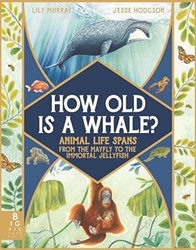
Animal Life Spans from the Mayfly to the Immortal Jellyfish
Review posted May 20, 2024.
Big Picture Press (Candlewick), 2023. First published in the United Kingdom in 2022. 64 pages.
Review written April 22, 2024, from a library book.
Here's an oversized awesome-for-poring-over children's cool animal facts book that looks at them from the perspective of how long do these creatures live? The subtitle gives away the beginning (Mayfly: 5 minutes to 24 hours) and ending (Immortal jellyfish: Immortal, in a manner of speaking) creatures. In between, there are 25 others, including the Monarch Butterfly (2 weeks to 8 months), Periodical Cicada (17 years), Trapdoor Spider (Female: 20 to 40 years; Male: 5 to 7 years), Echidna (45 years), Orange Roughy (100+ years), and Glass Sponge (11,000 years). Each creature is featured in a page or spread with lots of interesting facts about them and about their lifespan.
Here was an interesting fact I hadn't known:
At birth, all mammals (other than humans) have the same lifetime supply of heartbeats: a limit of around one billion. Smaller mammals tend to live shorter lives than larger mammals because their hearts beat more quickly. This is particularly true of the Etruscan shrew, one of the world's smallest mammals, which burns through its heartbeats at a furious rate of up to 1,500 beats per minute.
I was also alerted to the impact of lifespan on conservation in the text about the Orange Roughy fish, whose lifespan is over 100 years long:
They take at least twenty years to mature, grow very slowly, and do not breed every year. It is this slow-paced life that has made them so vulnerable to overfishing. It was once thought that orange roughy only lived for thirty years, and it was presumed they would cope with being fished in huge numbers, with their populations recovering quickly. Instead, their numbers crashed. Even in places where fishing for orange roughy has been restricted, it will take fifty years or more for the population of these remarkably long-lived fish to recover.
We've all known the kid who likes collecting interesting facts about unusual animals. This book will satisfy any such appetite.
